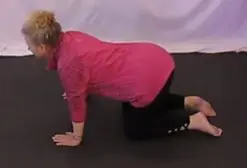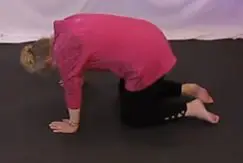Donald Duck and drb, but Hopefully Not You
Common, but Solvable Postural Problem
A good friend (I’ll call her ‘P’) is a tall, pretty woman, but with noticeably terrible posture. Frankly, weary of my insensitive commenting on it periodically, one night after a difficult project ‘P’ shot back “well, look at your slumped shoulders.” She was correct. Often when depressed or tired I will definitely look like I am “slumping.”
However, she missed my more consistent postural issue, one which started decades ago, and with which I still struggle regularly. It’s noticeable to me. Others may not register the problem, but just get an impression.
A Cartoon with Bad Looks
Let me say, I could have entitled this post “look 7 lbs. thinner in moments,” but who would have believed me. If I first explain that this posture is sometimes known as Donald Duck posture or Bulging Belly Syndrome, you might get the idea. However, you would probably think “ok, this means suck your stomach in.” Wrong.
In technical terms, it is an anterior pelvic tilt (APT). It causes your butt to stick out and because the hips are titled forward, the belly bulges. Hence the reason it can make us look heavier than we are. It can be tough to imagine or visualize, but the below graphic is a helpful description. Take a peek. Didn’t I tell you? For a person of typical weight, they can appear 5-7 lbs. heavier with an anterior titled pelvis.

Is this Common?
Unfortunately, many of us display this posture, even if not as pronounced as Donald’s. Numbers vary, but some professionals claim as much as 80% of the population. The more often I evaluate the stance of others, the more I notice it. No x-rays are needed, it’s clearer than that.
As you can see with the stick figure below, if you envision your pelvis as a pail, too often many of us stand with the water being dumped out of the pail, rather than it being contained within. It’s unsightly and exacerbates many problems, like low back pain.
I can attest to the fact that standing with a ‘straighter’ (more neutral) pelvis actually feels more stable and relaxing than the water-dumping anterior pelvis.
It looks better and feels better, but when it’s a habit, it’s difficult to break. However, because the pelvis is vital to us when we stand, walk, or lift weight, it’s worth the effort to improve.
Cause of Anterior Pelvic Tilt Posture?
If I could use only one word to answer the question about cause, it would have to be sitting. Excessive daily sitting, without stretching to counteract the effects, is the number one reason. The more sitting, the more likely is APT.
Lower-crossed syndrome (LCS) is sometimes considered simply another a.k.a, but if not, APT and LCS are still extremely similar. Imbalance of the pelvic and para-pelvic muscles (both flexibility and strength unevenness), as well as tightness of hip flexors and lumbar extensors all add to this whole belly bulge look.
Whatever we call it, due to the whole package of tightness, weakness and imbalance it is a compensatory pattern. Our body is compensating for these off-kilter factors.
More Causes
Granted, while the list of causations is a tiny bit longer, sitting merely wins the dubious first place of culprits. The list includes:
- Sitting or standing in poor posture
 Improper lifting or bending
Improper lifting or bending- Muscle imbalance around pelvis, back, hips and legs
- Obesity
- Pregnancy (which while seemingly temporary, can lead to long-term poor positioning).
When you demonstrate a tilt of the anterior pelvis, it generally indicates:
- Tight hip flexors (muscles that pull your thigh toward your torsos when you sit, walk, run or stand – the iliopsoas is the strongest of these)
- Weak hamstrings or gluteal muscles (in the buttocks)
- Weak core muscles
[See reference section for specific muscles.]
Results of these problems vary, but can lead to low back pain, hip and knee pain, incorrect posture (kind of obvious) and forced rotation of the knee and hip. As you can see in the graphics, it also interferes with our looks and stature.
It’s possible that there are psychological reasons for this body alignment – meaning leading with the stomach. If so, I’m not addressing them here.
How to Determine if You have an APT
There are 3 ways to test yourself for APT, or Anterior Pelvic Tilt. Two are more technical than the other.
Test 1
- Thomas Test. While the most common, I’m not impressed. You can easily do this test and still have an APT. Nevertheless, it can indicate tight front-thigh muscles, which is one cause of a titled pelvis.
- Sit on a firm bed or edge of a sturdy flat surface or table. Lie back so legs hang off at the knees.
- Pull 1 knee to chest, while other lies flat. [Check both legs.]
- Back of the resting leg SHOULD continue to lie flat and to touch the flat surface. If it doesn’t, you probably have tight hip flexors.
Note: my legs are always able to perform as they should, despite my tendency toward an APT.
Test 2
- Descending PSIS > ASIS line. My favorite, this is more accurate, but also more technical.
- Locate your PSIS (posterior superior iliac spine), the two bony prominences below the dimples in your low back.
- Locate your ASIS (anterior superior iliac spine), also bony prominences but in front of your hips at the top of your pelvis (keep thumbs there).
- With fingers on the PSIS and thumbs on the ASIS areas, draw an imaginary line.
- The line SHOULD be only slightly descending from PSIS > ASIS. If the line is descending more than an inch, it’s likely you have an anterior tilt.
Test 3
The Mirror Test. This may be the easiest and favorite for those unsure of body parts. You can look in the mirror, or have others report what they view, or you can take a timed picture or video with your phone. Whichever approach you take, evaluate whether these 3 signs are present. 1) your butt sticks out. 2) You ‘lead with the stomach,’ so belly sticks out, or 3) you have an exaggerated or excessive low back arch (hyperlordosis). All 3? You almost certainly have an APT.
Correcting an Anterior Pelvic Tilt
Is this correction easy? No. It takes time – months. But that time frame refers to making it second nature, and avoid pain and mobility problems that accompany an APT. You can instantly tilt your pelvis (and look thinner) in seconds, but if you want to keep that appearance you likely have to toil a bit more.
Luckily, work toward correction is easy and inexpensive.
Interestingly, some of the possible APT stretching and strengthening exercises are included in PizzazzEE-25. Later, that’s helpful for maintenance. Done in that program, an already-good posture is supported, but a tilt won’t be solved in the once-a-week (or so) workout. For lasting changes, therapeutic movements need to be executed with more repetitions and a couple times per week. Both stretching and strengthening are needed.
Three (3) Stretches for Correcting an APT
You will recognize some starting positions (both for stretches and strengthening) if you do PizzazzEE (a full-body workout engaging every muscle, every joint, every time). But there are several differences to these therapeutic exercises, so read carefully.
 1. Child’s Pose. This encourages the release of common tightness in back muscles, such as the Latissimus dorsi.
1. Child’s Pose. This encourages the release of common tightness in back muscles, such as the Latissimus dorsi.
— Start on your hands and knees
— Position yourself down with stomach close to the floor and knees slightly wider than hips.
— Turn toes inward to touch (picture does not show that).
— Push hips backward.
— Once comfortable, straighten arms forward and allow head to fall forward into a relaxed position.
— Hold this position for 15 to 20 seconds.
— Slowly return to the starting stance. Repeat 3 times.
—
2. Angry Cat. Motion helps stretch and loosen tight muscles in the back (especially Erector Spinae)

— Begin on hands and knees.
— Exhale and slowly suck in the stomach.
— Round your spine, press into the floor with hands and slightly curve your neck down (try to look at your feet).
— Inhale and let your stomach “droop” towards the floor as you look up towards the ceiling.
— Aim for 3-5 repetitions.
3. Half Kneeling Hip flexor. This excellent action will relax hip flexors and is said to increase hip flexibility.
— Begin by standing on a soft surface, lunge out with left leg until your right knee is resting (kneeling) on the floor.
— Check that left leg makes a 90-degree angle at your knee (knee over ankle).
— Tighten buttock and abdominal muscles to shift the pelvis under. Keep that tilt throughout.
— Lean forward with straight torso and feel tension in right inner thigh and hip.
— Optionally, for more stretch raise arm (of kneeling right knee) overhead and lean toward left leg.
— Hold for 10-20 seconds, release and repeat 5-10 times.
— SWITCH sides, performing 5-10 times on each side.
Note: keep pelvis slightly tilted and torso straight throughout stretch. Stretch should cause tension but not pain.
Four (4) Strengthening Exercises for Correcting an Anterior Pelvic Tilt
1. Squats. One of my favorite full-body exercises, this will strengthen several areas of muscles: back, gluteals, hamstrings and others.
 You may wish to perform this as shown in PizzazzEE-25, or use the normal therapeutic procedure.
You may wish to perform this as shown in PizzazzEE-25, or use the normal therapeutic procedure.
— Begin in a standing position with feet about shoulder width apart.
— Look straight ahead.
— Keep abdominals tight.
— Hinge at hips and bend knees to about a 90-degree angle (as if you’re sitting). Make certain knees are over ankles.
— When coming up, use your legs first; then follow up by squeezing the butt (glutes)
— Aim for 10 to 15 repetitions.
Note: best to squat at no more than a 90-degree angle. If you can’t do that angle, less will STILL work these muscles.
 2. Plank. (Advanced move on Push and Plank from PizzazzEE-25). Good for strengthening both gluteal and core muscles.
2. Plank. (Advanced move on Push and Plank from PizzazzEE-25). Good for strengthening both gluteal and core muscles.
— Lie on your stomach with forearms on floor or mat, and elbows at shoulder level.
— Engage core muscles, lifting body so that you are resting on your forearms and toes.
— Confirm that you are in a neutral spinal position (not sagging at low back, or with a lifted butt).
— Hold the plank position for 10-20 seconds (30 if you prefer). And slowly lower down.
— Depending on the time held, attempt 2-5 repetitions.
3. Glute Bridge (a portion of ‘Paint the Floor” in PizzazzEE-25, done in a tad different position). While this Exercise will help stretch lower back muscles, it will also strengthen abdominal, core, gluteal and back muscles.
 — Begin lying on your back with knees bent and feet positioned flat on floor (for this exercise, put arms beside your torso).
— Begin lying on your back with knees bent and feet positioned flat on floor (for this exercise, put arms beside your torso).
— Brace core muscles and squeeze your butt before any movement.
— While bracing, lift your butt off the floor, and continue squeezing gluteal muscles. (Keep torso straight, without hyperextending your back)
— Hold position 5 seconds; return slowly to starting position.
— Repeat 8-10 times.
Note: doing extra repetitions for some of these exercises may accelerate your triumph over APT, but should NOT make you sore the next day.
 4. Bird Dog (second half of ‘Angry Cat and Bird Dog” in PizzazzEE-25) helps improve lumbar back muscles as well as core strength.
4. Bird Dog (second half of ‘Angry Cat and Bird Dog” in PizzazzEE-25) helps improve lumbar back muscles as well as core strength.
— Beginning on ‘all-fours,’ put hands under shoulders and knees under hips.
— Tighten core muscles as hard as you can.
— While bracing core, raise arm and reach forward until arm is aligned with torso; at the same time, stretch your opposite leg backward until it’s also aligned with torso.
— Hold position 2-3 seconds before slowly returning to starting position.
— Repeat with opposite arm and leg.
— Alternate sides for 8-10 repetitions.
Note: Try not to arch low back as you perform this move.
Passive Treatment
Whether you or your doc (MD, DO or DC) think you need extra treatment to jump-start improvement, there are options. Two ancillary treatments I would consider initially are:
- Myofascial release Therapy (or a similar soft-tissue mobilization treatment).
- Proprioceptive neuromuscular facilitation (PNF). PNF rehabilitates movement with a combination of techniques, stimulating the neuro-muscular system to break holding patterns and produce the wanted outcome.
An important key to consider for APT, or any other postural / muscular imbalance, is that we do not want to strengthen already over-active (and compensating) muscles. It will often exacerbate a condition.
FINAL THOUGHT
Relearning posture is difficult. It’s never as easy as ‘exercises’ sound, and you will have set-backs. When I’m standing at the sink or counter, I still sometimes find myself with my stomach “stabilizing” me. To be clear, I’m being facetious. It isn’t stabilizing me at all, but conversely demonstrating an unsightly belly bulge and poorly functioning posture. Still, it reminds me to rock my pelvis and stand straighter. It almost always takes pressure off the back.
Indeed, the exercises here are helpful. Nevertheless, it is equally important to teach your body the muscle memory it needs for a good pelvis stance. You can learn what a neutral pelvis is supposed to feel like simply by correcting the posture in the moment. Plus, you can inconspicuously practice this correction, and develop muscle memory, frequently throughout the day.
Practicing the improved posture is an immediate way to look slightly taller and to drop the appearance of that 5-7 extra lbs. You look your best. No more Donald Duck.
—
Picture Credits
Title picture: Donald duck image by MuSA DS, licensed and attributed to vecteezy.com
Graphic showing two women is used with permission from Back Intelligence at BackIntellegence.com (Website also includes exercises for Anterior Pelvic Tilt.) See: How To Fix Anterior Pelvic Tilt Posture – 10 Exercises | Back Intelligence .
Stick person – public domain. Credit: By Anonymous – Posture Foundation Garments (04fig1.png) Public Domain https://commons.wikimedia.org/w/index.php?curid=2479742
Various other shots taken from PizzazzEE-25 workout app.
References:
Warvasz, G. Exercise Strategies to Prevent the Development of the Anterior Pelvic Tilt: Implications for Possible Prevention of Sports Hernias and Osteitis Pubis. Strength and Conditioning Journal, August 2010. https://pdfs.semanticscholar.org/0213/288e3772f12e7673dd3f8702f6cab9d98345.pdf
Won-gyu Yoo. Effect of Individual Strengthening Exercises for Anterior Pelvic Tilt Muscles on Back Pain, Pelvic Angle, and Lumbar ROMs of a LBP Patient with Flat Back – PMC (nih.gov) J. Phys Ther Sci 2013 Oct 25 (10).
Note on muscles involved with treating an anterior pelvic tilt. As mentioned throughout this piece, some muscles need to be strengthened and others need to be stretched.
Weak muscles to strengthen include:
— Core muscles (rectus abdominus, internal/ external obliques, and transverse abdominus)
— Gluteal muscles (gluteus maximus, medius, and minimus)
Tight muscles to be relaxed or stretched include:
– Hip flexors (like psoas, iliacus, tensor fascia latae, rectus femoris)
– Back extensors (specifically this includes erector spinae, multifidus, quadratus lumborum, and latissimus dorsi)
The post Donald Duck and drb, but Hopefully Not You appeared first on Aging with Pizzazz.

 Improper lifting or bending
Improper lifting or bending





















